Pathophysiology of Acute Rheumatic Fever in a 14-Year-Old Girl
VerifiedAdded on 2020/06/06
|5
|685
|52
Report
AI Summary
This report provides a detailed analysis of the pathophysiology of Acute Rheumatic Fever (ARF), focusing on a case study of a 14-year-old Aboriginal girl. The report explains that ARF is an inflammatory condition resulting from untreated group A streptococcal infections. It details the immune response, including molecular mimicry and the formation of Aschoff bodies, and describes the impact on the heart, leading to conditions like pancarditis and aortic regurgitation. The analysis highlights the importance of early treatment of streptococcal infections to prevent ARF and its long-term consequences. The report references key research papers and online resources to support its findings.
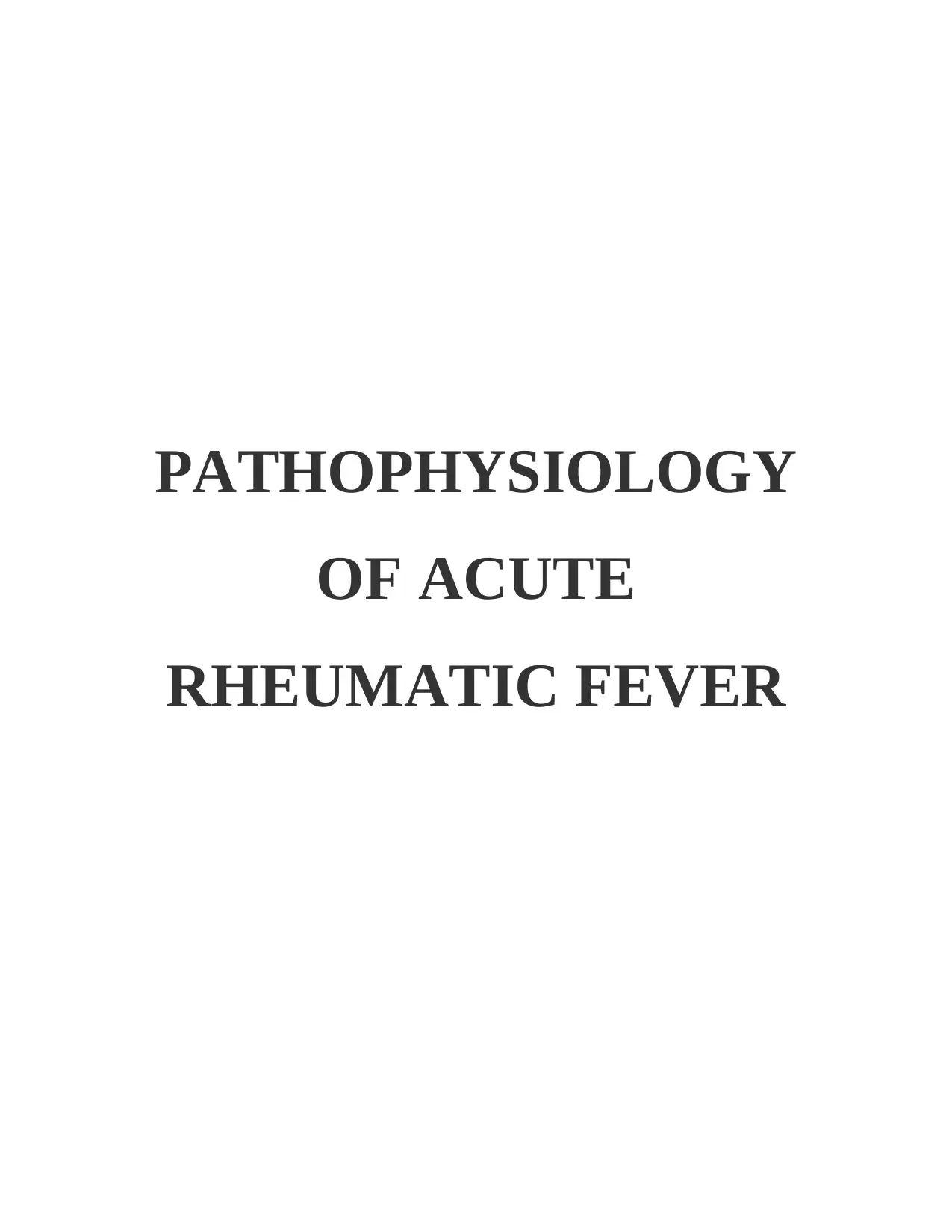
PATHOPHYSIOLOGY
OF ACUTE
RHEUMATIC FEVER
OF ACUTE
RHEUMATIC FEVER
Paraphrase This Document
Need a fresh take? Get an instant paraphrase of this document with our AI Paraphraser
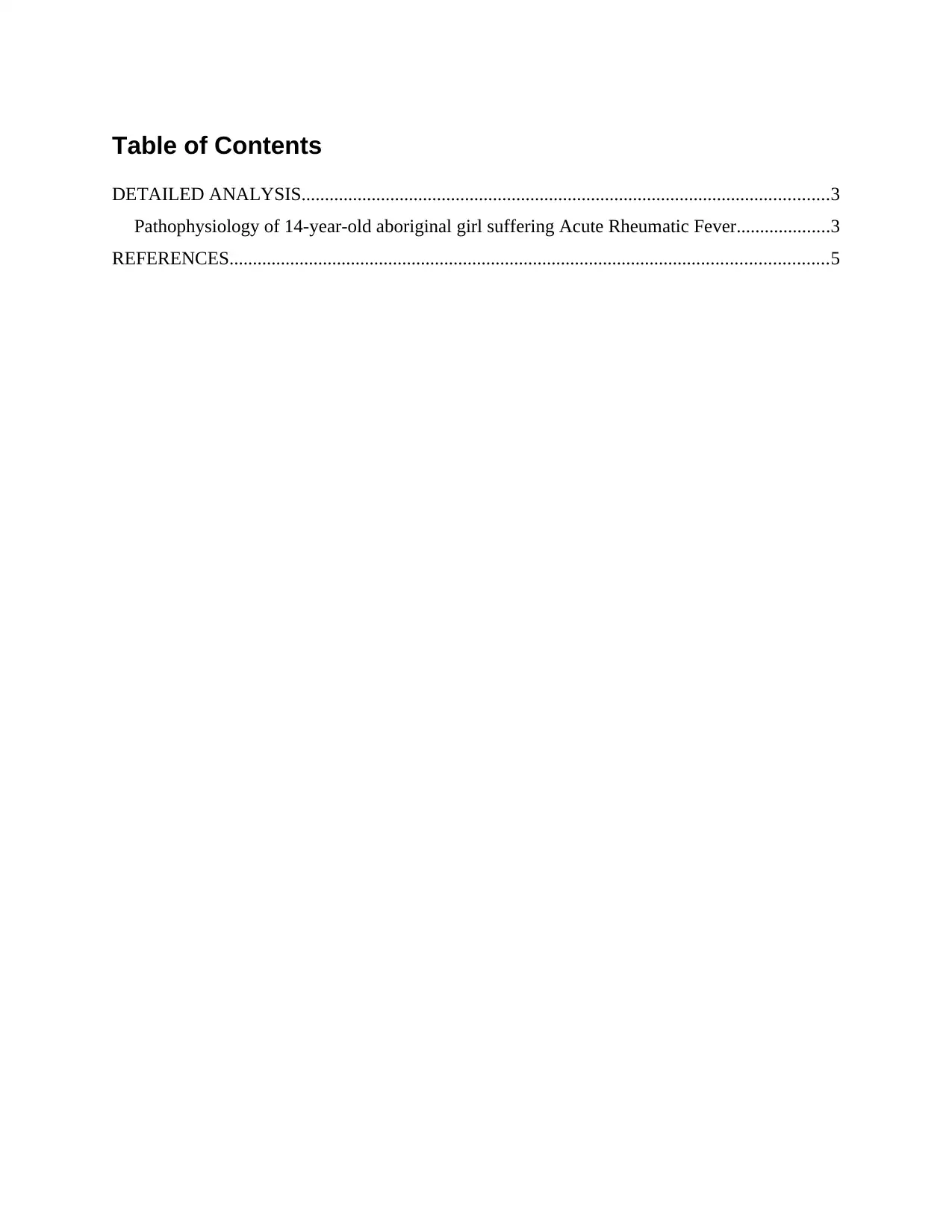
Table of Contents
DETAILED ANALYSIS.................................................................................................................3
Pathophysiology of 14-year-old aboriginal girl suffering Acute Rheumatic Fever....................3
REFERENCES................................................................................................................................5
DETAILED ANALYSIS.................................................................................................................3
Pathophysiology of 14-year-old aboriginal girl suffering Acute Rheumatic Fever....................3
REFERENCES................................................................................................................................5
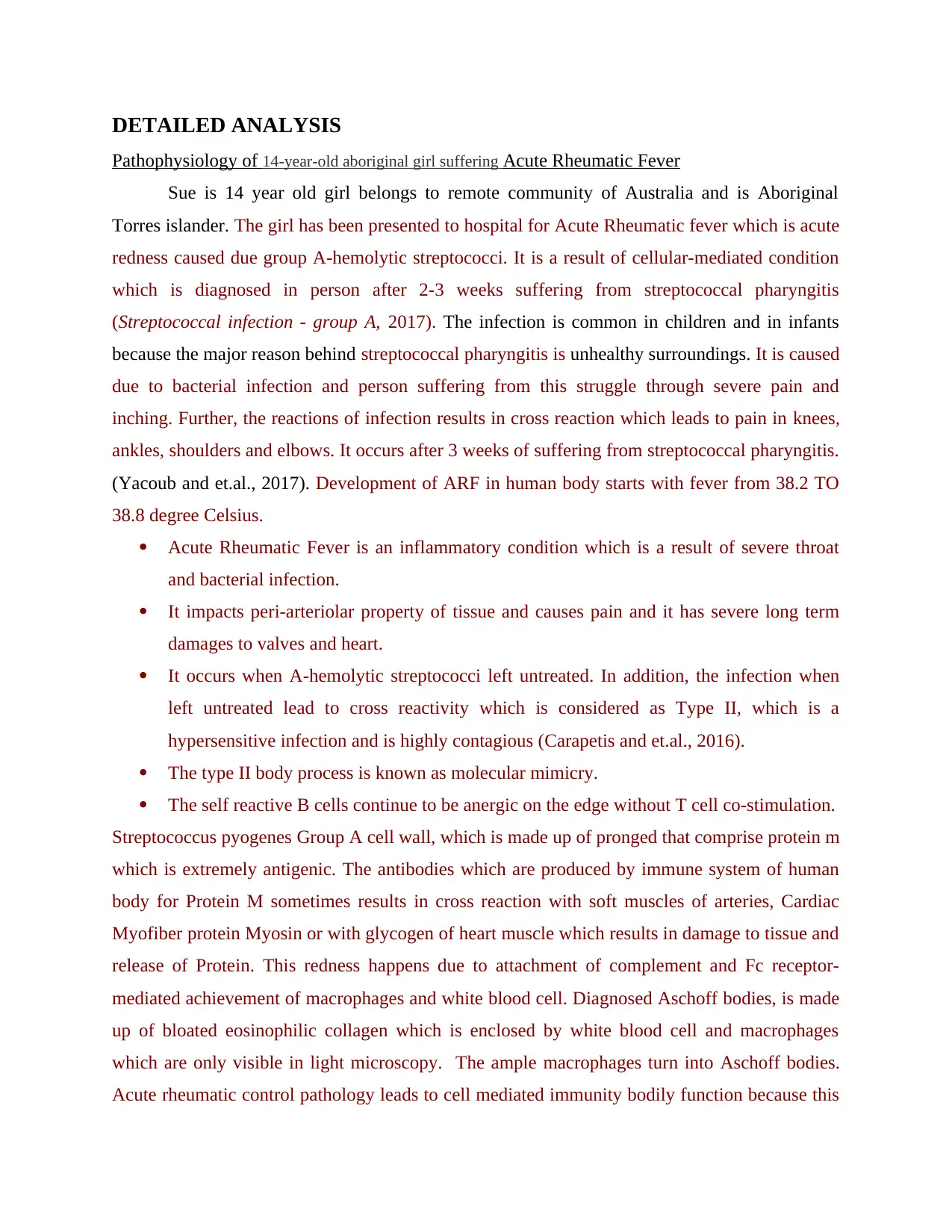
DETAILED ANALYSIS
Pathophysiology of 14-year-old aboriginal girl suffering Acute Rheumatic Fever
Sue is 14 year old girl belongs to remote community of Australia and is Aboriginal
Torres islander. The girl has been presented to hospital for Acute Rheumatic fever which is acute
redness caused due group A-hemolytic streptococci. It is a result of cellular-mediated condition
which is diagnosed in person after 2-3 weeks suffering from streptococcal pharyngitis
(Streptococcal infection - group A, 2017). The infection is common in children and in infants
because the major reason behind streptococcal pharyngitis is unhealthy surroundings. It is caused
due to bacterial infection and person suffering from this struggle through severe pain and
inching. Further, the reactions of infection results in cross reaction which leads to pain in knees,
ankles, shoulders and elbows. It occurs after 3 weeks of suffering from streptococcal pharyngitis.
(Yacoub and et.al., 2017). Development of ARF in human body starts with fever from 38.2 TO
38.8 degree Celsius.
Acute Rheumatic Fever is an inflammatory condition which is a result of severe throat
and bacterial infection.
It impacts peri-arteriolar property of tissue and causes pain and it has severe long term
damages to valves and heart.
It occurs when A-hemolytic streptococci left untreated. In addition, the infection when
left untreated lead to cross reactivity which is considered as Type II, which is a
hypersensitive infection and is highly contagious (Carapetis and et.al., 2016).
The type II body process is known as molecular mimicry.
The self reactive B cells continue to be anergic on the edge without T cell co-stimulation.
Streptococcus pyogenes Group A cell wall, which is made up of pronged that comprise protein m
which is extremely antigenic. The antibodies which are produced by immune system of human
body for Protein M sometimes results in cross reaction with soft muscles of arteries, Cardiac
Myofiber protein Myosin or with glycogen of heart muscle which results in damage to tissue and
release of Protein. This redness happens due to attachment of complement and Fc receptor-
mediated achievement of macrophages and white blood cell. Diagnosed Aschoff bodies, is made
up of bloated eosinophilic collagen which is enclosed by white blood cell and macrophages
which are only visible in light microscopy. The ample macrophages turn into Aschoff bodies.
Acute rheumatic control pathology leads to cell mediated immunity bodily function because this
Pathophysiology of 14-year-old aboriginal girl suffering Acute Rheumatic Fever
Sue is 14 year old girl belongs to remote community of Australia and is Aboriginal
Torres islander. The girl has been presented to hospital for Acute Rheumatic fever which is acute
redness caused due group A-hemolytic streptococci. It is a result of cellular-mediated condition
which is diagnosed in person after 2-3 weeks suffering from streptococcal pharyngitis
(Streptococcal infection - group A, 2017). The infection is common in children and in infants
because the major reason behind streptococcal pharyngitis is unhealthy surroundings. It is caused
due to bacterial infection and person suffering from this struggle through severe pain and
inching. Further, the reactions of infection results in cross reaction which leads to pain in knees,
ankles, shoulders and elbows. It occurs after 3 weeks of suffering from streptococcal pharyngitis.
(Yacoub and et.al., 2017). Development of ARF in human body starts with fever from 38.2 TO
38.8 degree Celsius.
Acute Rheumatic Fever is an inflammatory condition which is a result of severe throat
and bacterial infection.
It impacts peri-arteriolar property of tissue and causes pain and it has severe long term
damages to valves and heart.
It occurs when A-hemolytic streptococci left untreated. In addition, the infection when
left untreated lead to cross reactivity which is considered as Type II, which is a
hypersensitive infection and is highly contagious (Carapetis and et.al., 2016).
The type II body process is known as molecular mimicry.
The self reactive B cells continue to be anergic on the edge without T cell co-stimulation.
Streptococcus pyogenes Group A cell wall, which is made up of pronged that comprise protein m
which is extremely antigenic. The antibodies which are produced by immune system of human
body for Protein M sometimes results in cross reaction with soft muscles of arteries, Cardiac
Myofiber protein Myosin or with glycogen of heart muscle which results in damage to tissue and
release of Protein. This redness happens due to attachment of complement and Fc receptor-
mediated achievement of macrophages and white blood cell. Diagnosed Aschoff bodies, is made
up of bloated eosinophilic collagen which is enclosed by white blood cell and macrophages
which are only visible in light microscopy. The ample macrophages turn into Aschoff bodies.
Acute rheumatic control pathology leads to cell mediated immunity bodily function because this
⊘ This is a preview!⊘
Do you want full access?
Subscribe today to unlock all pages.

Trusted by 1+ million students worldwide
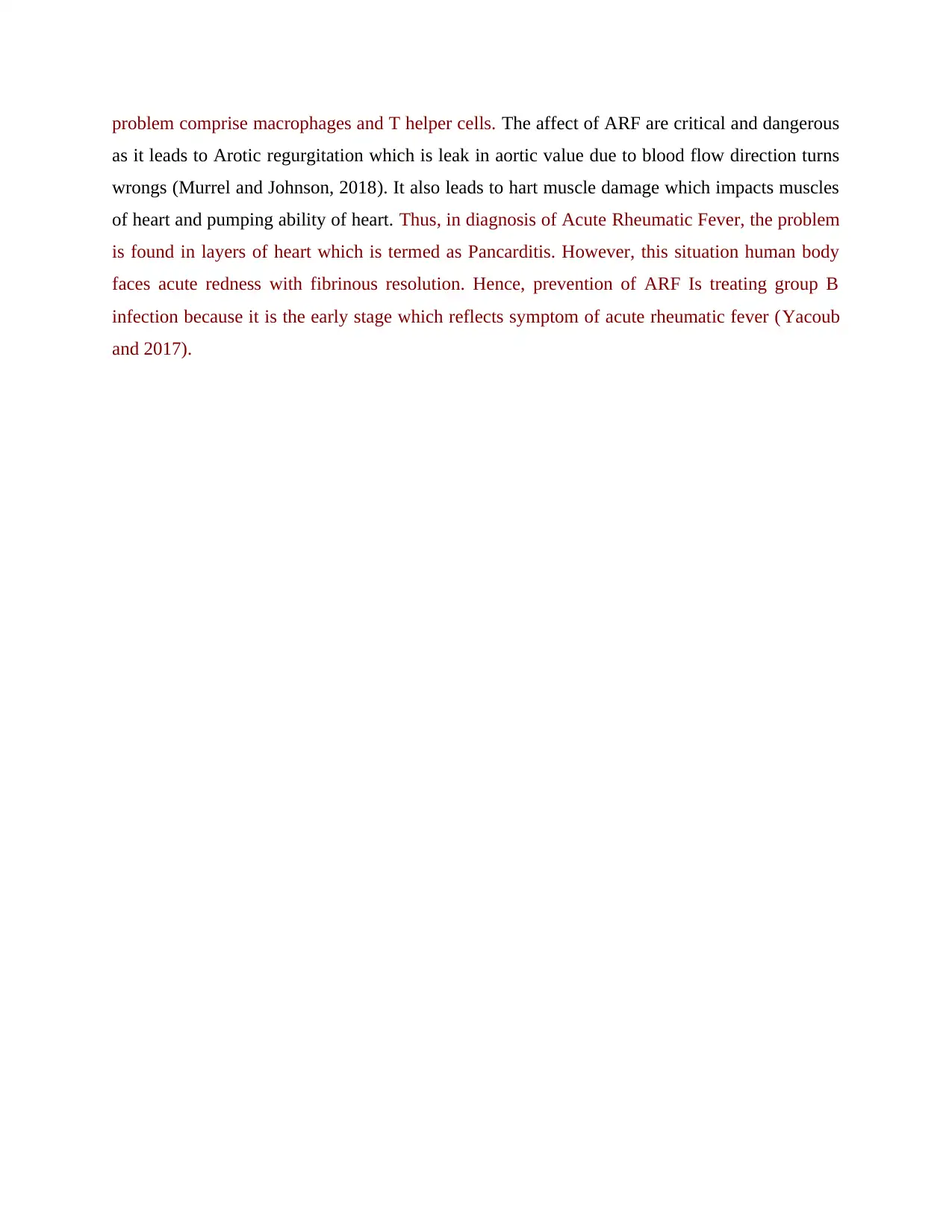
problem comprise macrophages and T helper cells. The affect of ARF are critical and dangerous
as it leads to Arotic regurgitation which is leak in aortic value due to blood flow direction turns
wrongs (Murrel and Johnson, 2018). It also leads to hart muscle damage which impacts muscles
of heart and pumping ability of heart. Thus, in diagnosis of Acute Rheumatic Fever, the problem
is found in layers of heart which is termed as Pancarditis. However, this situation human body
faces acute redness with fibrinous resolution. Hence, prevention of ARF Is treating group B
infection because it is the early stage which reflects symptom of acute rheumatic fever (Yacoub
and 2017).
as it leads to Arotic regurgitation which is leak in aortic value due to blood flow direction turns
wrongs (Murrel and Johnson, 2018). It also leads to hart muscle damage which impacts muscles
of heart and pumping ability of heart. Thus, in diagnosis of Acute Rheumatic Fever, the problem
is found in layers of heart which is termed as Pancarditis. However, this situation human body
faces acute redness with fibrinous resolution. Hence, prevention of ARF Is treating group B
infection because it is the early stage which reflects symptom of acute rheumatic fever (Yacoub
and 2017).
Paraphrase This Document
Need a fresh take? Get an instant paraphrase of this document with our AI Paraphraser
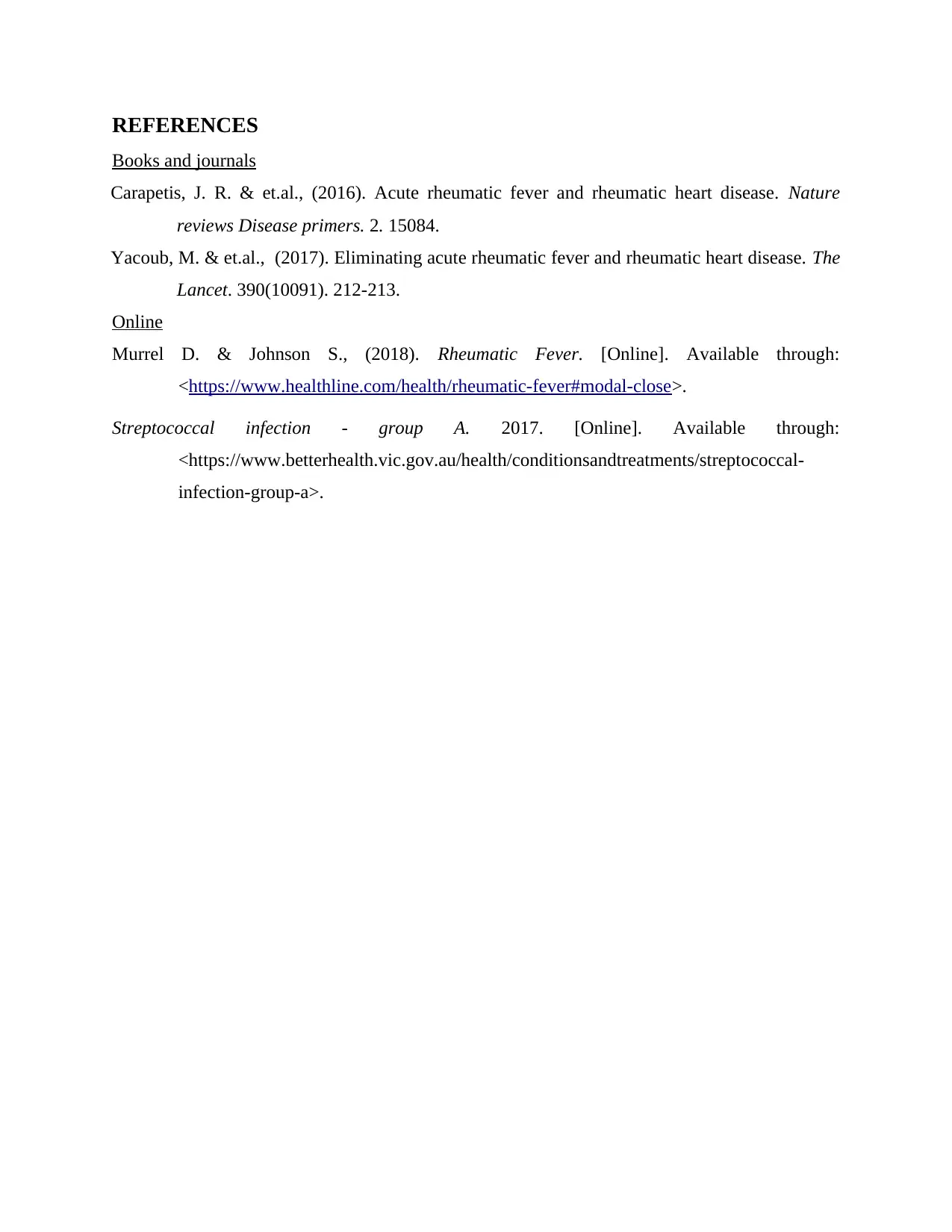
REFERENCES
Books and journals
Carapetis, J. R. & et.al., (2016). Acute rheumatic fever and rheumatic heart disease. Nature
reviews Disease primers. 2. 15084.
Yacoub, M. & et.al., (2017). Eliminating acute rheumatic fever and rheumatic heart disease. The
Lancet. 390(10091). 212-213.
Online
Murrel D. & Johnson S., (2018). Rheumatic Fever. [Online]. Available through:
<https://www.healthline.com/health/rheumatic-fever#modal-close>.
Streptococcal infection - group A. 2017. [Online]. Available through:
<https://www.betterhealth.vic.gov.au/health/conditionsandtreatments/streptococcal-
infection-group-a>.
Books and journals
Carapetis, J. R. & et.al., (2016). Acute rheumatic fever and rheumatic heart disease. Nature
reviews Disease primers. 2. 15084.
Yacoub, M. & et.al., (2017). Eliminating acute rheumatic fever and rheumatic heart disease. The
Lancet. 390(10091). 212-213.
Online
Murrel D. & Johnson S., (2018). Rheumatic Fever. [Online]. Available through:
<https://www.healthline.com/health/rheumatic-fever#modal-close>.
Streptococcal infection - group A. 2017. [Online]. Available through:
<https://www.betterhealth.vic.gov.au/health/conditionsandtreatments/streptococcal-
infection-group-a>.
1 out of 5
Related Documents
Your All-in-One AI-Powered Toolkit for Academic Success.
+13062052269
info@desklib.com
Available 24*7 on WhatsApp / Email
![[object Object]](/_next/static/media/star-bottom.7253800d.svg)
Unlock your academic potential
Copyright © 2020–2025 A2Z Services. All Rights Reserved. Developed and managed by ZUCOL.




